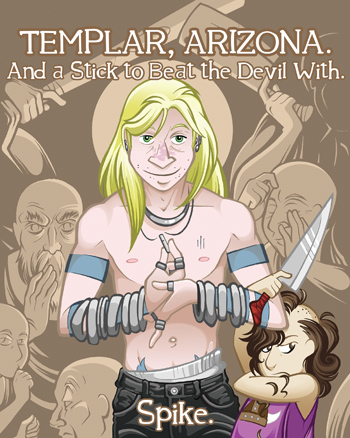Two of my favorite webcomics—Templar, AZ and Jump Leads—are preparing to have volumes of the online comic printed out in book form. For Templar, AZ this is the third volume, and for Jump Leads it’s their first.
Templar, AZ is about a fictional Arizona town in an alternate version of our current world heck, just go here and the writer/artist (Spike, aka Charlie Trotman) can tell you more thoroughly about it. I love that with every one-page comic I learn more about the world in which this is set while still getting the ongoing story. The artwork is top-notch, the characters believeable, and the storyline captivating. But don’t listen to me jabber about, go check it out!
Jump Leads follows Lead Service trainees Meaney and Llewellyn as they try to complete their training to become part of the so-called “reality police.” Unfortunately, their JumpShip, which allows them to jump through time and space, is broken and they can’t control where it goes. There are more details here.
Stylistically, Jump Leads is more angular and stark where Templar, AZ is full of curves and soft edges. Jump Leads is more episodic with the two trainees trading jibes as they jump from one place to the next, while Templar, AZ is a growing, expanding story. All the same, the two webcomics scratch very different parts of my reader brain; I only wish they would come out more often. And now, I can get a copy of my own to put on the shelf and enjoy whenever I want!
I do find it curious that many webcomics end up making and selling print editions. I realize that this can be a major source of income for the people involved. Perhaps not enough to earn a living, but more than enough to compensate for the costs of getting the work online. Plus it can give these artists a way to reach an audience that’s not reading stuff online.
There’s precedence for this, too. You can read Dilbert or Garfield or Bizarro online for free every day, but they still publish print collections of the daily comics. Heck, Garfield just put out collection number 47. And while you could clip the comics from the newspaper or print them out from online and put together your own binder of comics, it’s easier, and often better quality, to purchase the official publication.
If you look into the comic book world, this is done all the time. Runs of issues are collected together into graphic novels, often purchased by the same readers (who in essence are buying the content twice, then), but just as often bought by readers who want to be able to sit down and read a larger volume of content at one time.
Of course these days there are more and more stories that are written directly for the graphic novel format, but there are still a lot of graphic novels that are essentially reprints of the original comic. In cases where the original issues are long out of print or old, this can be a great boon for the reader who either never had the original comics, or doesn’t want to put wear and tear on potentially collectible/fragile material.
This is perfected in Japan where individual manga story lines are initially published in magazines like Shonen Jump, Shonen Ace, or Shojo Beat as something akin to a short story and then collected into manga books. There are a lot of readers who buy the individual magazine issues and the manga books. Of course, in this case you can have the magazine with a wide variety of content, and then buy the bound volumes for only the titles you really like.
The reason I find this curious in the case of webcomics is that these creators have chosen to eschew paper in order to get their story out, but then find a reason to come back to paper in order to keep the non-paper entity going. This is the model that Clarkesworld Magazine and Fantasy Magazine are currently running. I like the model, and it works well for webcomics since it plays into the graphic novel readership that’s already out there. I’ll be interested to see how it works for fiction.
[Image from Spike; used with permission.]










